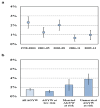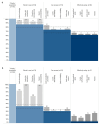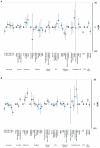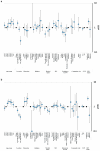Gender Norms and Structural Barriers to Use of HIV Prevention in Unmarried and Married Young Women in Manicaland, Zimbabwe: An HIV Prevention Cascade Analysis
- PMID: 40895466
- PMCID: PMC12397500
- DOI: 10.12688/gatesopenres.15127.2
Gender Norms and Structural Barriers to Use of HIV Prevention in Unmarried and Married Young Women in Manicaland, Zimbabwe: An HIV Prevention Cascade Analysis
Abstract
Background: Gender norms against adolescent girls and young women (AGYW)'s having pre-marital sex and using condoms in marriage are included as barriers to motivation to use condoms in HIV prevention cascades. Representative data on gender norms are needed to test this assumption.
Methods: General-population survey participants in Manicaland, Zimbabwe (ages≥15, N=9803) reported agreement/disagreement with statements on gender norms. AGYW at risk of HIV infection reported whether community views discouraged condom use. Multivariable logistic regression was used to measure associations between AGYW's perceiving negative gender norms and condom HIV prevention cascades.
Results: 57% of men and 70% of women disagreed that 'If I have a teenage daughter and she has sex before marriage, I would be ok with this'; and 41% of men and 57% of women disagreed that 'If I have a teenage daughter, I would tell her about condoms'. 32% and 69% of sexually-active HIV-negative unmarried AGYW, respectively, said negative community views were important in their decisions to use condoms and their friends were not using condoms. In each case, those who agreed had lower motivation to use condoms. Fewer unmarried AGYW with friends not using condoms used condoms themselves (39% vs. 68%; age- and site-adjusted odds ratios (aOR)=0.29, 95%CI, 0.15-0.55). 21% of men and 32.5% of women found condom use in marriage acceptable. 74% and 93% of married AGYW at risk, respectively, said negative community views influenced their decisions to use condoms and their friends did not use condoms. Fewer married AGYW reporting friends not using condoms were motivated to use condoms but no difference was found in their own condom use (4.1% vs. 6.9%; aOR=0.57, 95%CI, 0.08-2.66).
Conclusions: Negative gender norms can form a barrier to motivation to use condoms in unmarried and married AGYW at risk of HIV infection, and, for unmarried AGYW, to condom use.
Keywords: AGYW; HIV; HIV prevention cascades; Social norms; Structural barriers; Zimbabwe.
Copyright: © 2025 Gregson S et al.
Conflict of interest statement
Competing interests: SG declares shareholdings in pharmaceutical companies (GlaxoSmithKline and Astra Zeneca).
Figures







Similar articles
-
The role of social networks in motivating access and use of contraceptives among adolescent girls and young women living in resource-constrained settings in Cape Town, South Africa.Reprod Health. 2025 Jun 20;22(1):104. doi: 10.1186/s12978-025-02066-2. Reprod Health. 2025. PMID: 40542405 Free PMC article.
-
Prescription of Controlled Substances: Benefits and Risks.2025 Jul 6. In: StatPearls [Internet]. Treasure Island (FL): StatPearls Publishing; 2025 Jan–. 2025 Jul 6. In: StatPearls [Internet]. Treasure Island (FL): StatPearls Publishing; 2025 Jan–. PMID: 30726003 Free Books & Documents.
-
Awareness, access to and uptake of HIV prevention interventions among youth in Zimbabwe: a population-based survey.BMC Infect Dis. 2025 May 16;25(1):709. doi: 10.1186/s12879-025-11076-1. BMC Infect Dis. 2025. PMID: 40380099 Free PMC article. Clinical Trial.
-
Behavioral interventions to reduce risk for sexual transmission of HIV among men who have sex with men.Cochrane Database Syst Rev. 2008 Jul 16;(3):CD001230. doi: 10.1002/14651858.CD001230.pub2. Cochrane Database Syst Rev. 2008. PMID: 18646068
-
Behavioral interventions for improving condom use for dual protection.Cochrane Database Syst Rev. 2013 Oct 26;2013(10):CD010662. doi: 10.1002/14651858.CD010662.pub2. Cochrane Database Syst Rev. 2013. PMID: 24163112 Free PMC article.
References
-
- Liefbroer AC, Billari FC: Bringing norms back in: a theoretical and empirical discussion of their importance for understanding demographic behaviour. Popul Space Place. 2010;16(4):287–305. 10.1002/psp.552 - DOI
-
- Bourdillon MFC: Where are the Ancestors? Changing culture in Zimbabwe.Harare: University of Zimbabwe,1993. Reference Source
-
- UNAIDS: IN DANGER: UNAIDS Global AIDS Update 2022. In: Geneva, Switzerland: UNAIDS,2022;376. Reference Source
MeSH terms
LinkOut - more resources
Full Text Sources
Medical

